Menus
- 2016 vs. 2017
- ergonomics
- Operation / equipment
- engine
- Sound
- circuit
- suspension
- Steering behavior and handling
- security
- Conclusion
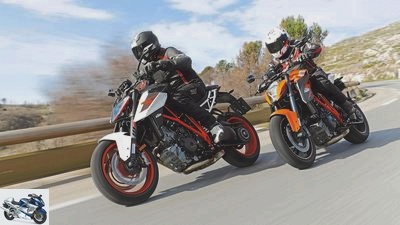

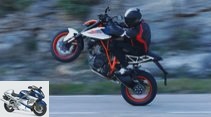
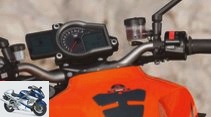
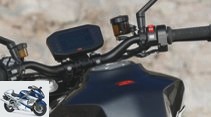
22nd photos
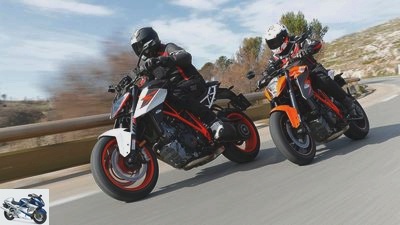
1/22
Even a super duke cannot rest on titles and laurels. Therefore, after three years, KTM brings the second evolutionary stage of the 1290 Super Duke R: “The Beast 2.0”! What can the new one do better than the old one??
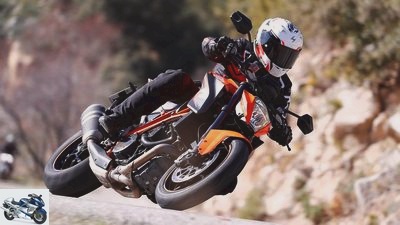
2/22
Smoke without end thanks to an unearthly V2 engine, but certain deductions in the B grade for suspension and steering behavior.
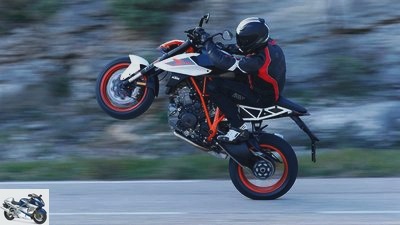
3/22
Even more pressure. More important: The new one is better in everyday life and offers modern assistance systems – can be deactivated for fun inserts.
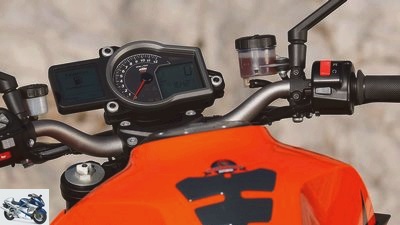
4/22
Comparison of the KTM 1290 Super Duke R old / new
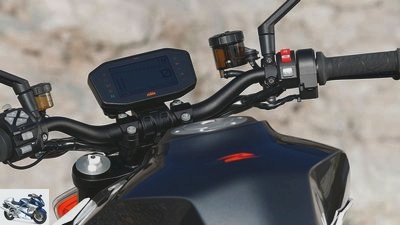
5/22
Comparison of the KTM 1290 Super Duke R old / new

6/22
The old one got by without a flap exhaust, so the sound remains more subtle.
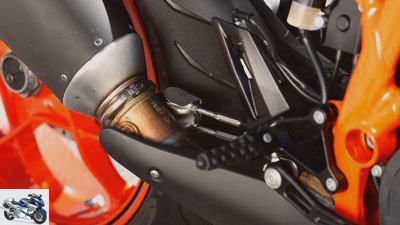
7/22
The exhaust flap with servomotor brings sound, but also additional weight, which is why the new one put on a few kilos.
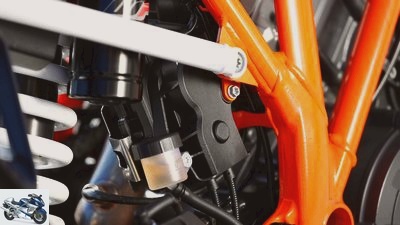
8/22
The exhaust flap with servomotor brings sound, but also additional weight, which is why the new one put on a few kilos.
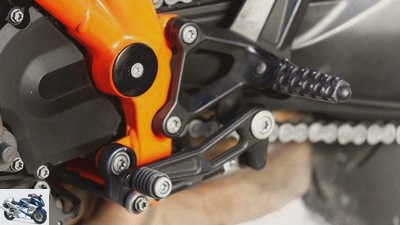
9/22
Even with the old one, the gear lever step could be screwed on in three positions; it is shorter than the new one.
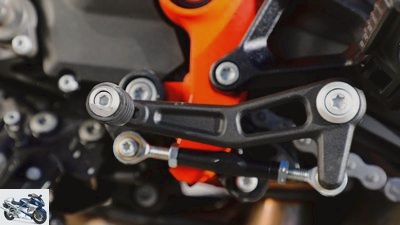
10/22
Comparison of the KTM 1290 Super Duke R old / new
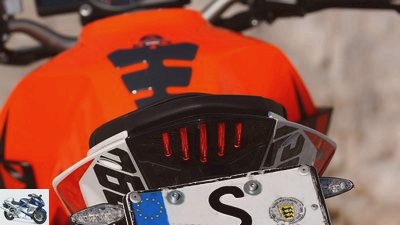
11/22
The old one also had the LED rear light, the rear was wider because of the cladding. But it didn’t look bad either.
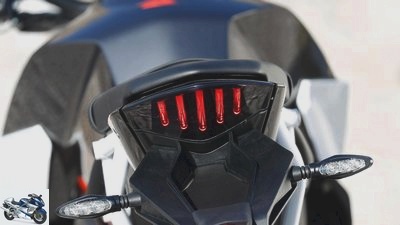
12/22
Narrow hips emphasize the broad shoulders: The now undisguised rear makes the muscular Duke narrower at the back.
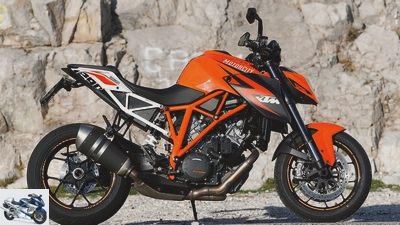
13/22
Comparison of the KTM 1290 Super Duke R old / new
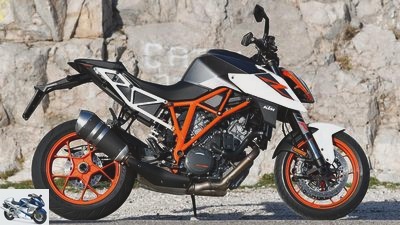
14/22
Comparison of the KTM 1290 Super Duke R old / new
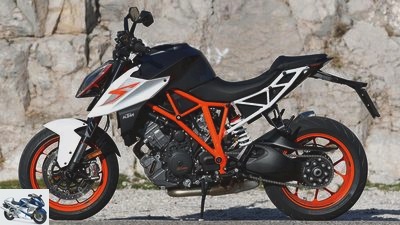
15/22
Comparison of the KTM 1290 Super Duke R old / new
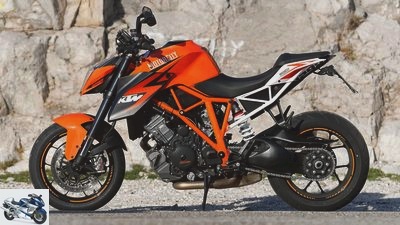
16/22
Comparison of the KTM 1290 Super Duke R old / new
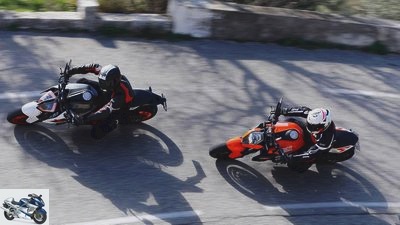
17/22
Comparison of the KTM 1290 Super Duke R old / new
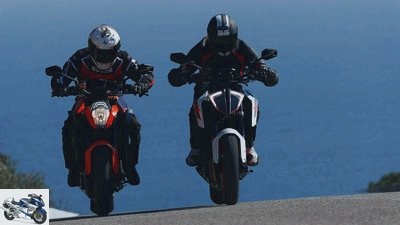
18/22
Comparison of the KTM 1290 Super Duke R old / new
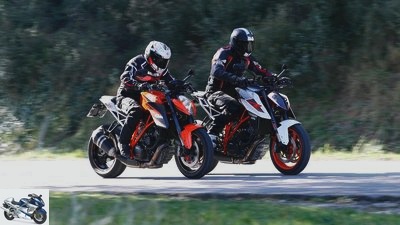
19/22
Comparison of the KTM 1290 Super Duke R old / new
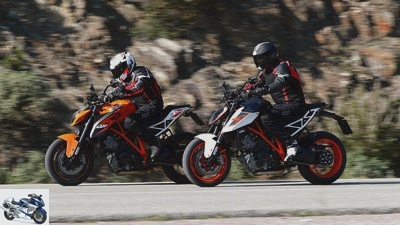
20/22
Comparison of the KTM 1290 Super Duke R old / new
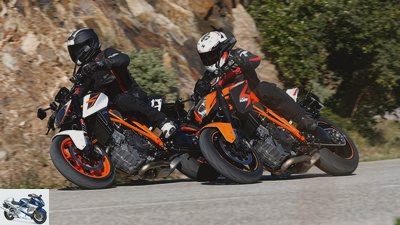
21/22
Comparison of the KTM 1290 Super Duke R old / new
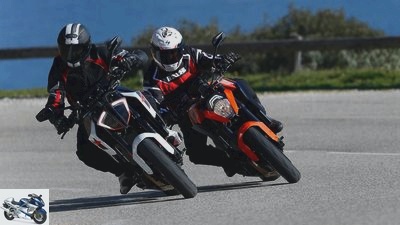
22/22
Comparison of the KTM 1290 Super Duke R old / new
KTM 1290 Super Duke R old and new in comparison test
2016 vs. 2017
Even a super duke cannot rest on titles and laurels. Therefore, after three years, KTM is bringing the second evolutionary stage of the KTM 1290 Super Duke R: “The Beast 2.0”! What can the new one do better than the old one??
We were all pretty puzzled back then, at the end of 2013: BMW and KTM presented their new Power-Nakeds every few weeks, and they were both different than expected. Upside-down world: the BMW S 1000 R was surprisingly wild, loud, extroverted. And the KTM 1290 Super Duke R, for the presentation of which many journalists traveled in tails after all the fanfare, then turned out to be acoustically subtle, tame and easy to use.
Buy complete article
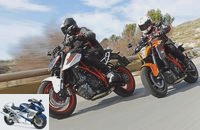
KTM 1290 Super Duke R old and new in comparison test
2016 vs. 2017
design
That is new: Fresh styling, split LED headlights.
What’s the point? Design is certainly a matter of taste, but the new one looks much more modern, especially from the front. The split headlight front is KTM’s trademark from this model year and can be found on the small Duke models such as the Adventure line. That alone makes the old woman look old. The bare rear makes the 1290s even more muscular and broad-shouldered. Although some testers were of the opinion that the previous rear fairing didn’t look bad either. As I said: it’s all a matter of opinion.
ergonomics
That is new: Handlebar shape and position.
What’s the point? Apart from the new, finer upholstery, the seat remained unchanged, but the handlebars are now half a centimeter flatter, almost two centimeters wider and less cranked. That was well received by the testers. With the old Super Duke you could always feel a hint of Suzuki feeling, the less curved handlebar ends of the new ones feel more like KTM. There are still four mounting positions. So far, the handlebars have been fitted to the rear as standard, but on the test machine it was in the front position. It fits better, puts more pressure on the front wheel, but is by no means more uncomfortable.
Operation / equipment
That is new: TFT cockpit, keyless go, LED light.
What’s the point? Sure, in comparison with the bright, colored TFT display, the LCD display looks pale, old-style. But not everything was worse in the past: the large, conventional rev counter, for example. The tricky bar chart of the new ones provides reference values at best. Further information is easier to read. The illuminated switches are also practical. Unfortunately, the sluggish flasher switch on the new one now gives no feeling when switching off. Also new: the cruise control, a pleasant thing for connecting stages. And the transponder key, which some find practical, others dispensable. The KTM menu structure is logically structured, but it still requires a lot of keystrokes. That could work more simply and quickly, the current competition proves it. Definitely a step forward: the new LED light illuminates the road more brightly than the previous headlights.
engine
That is new: Euro 4 vote, titanium intake valves, higher compression.
What’s the point? Let’s forget about the extra performance. Whether 180 hp (as promised first), 168 hp (as then delivered) or 177 hp (as now promised and delivered): it doesn’t matter. Because the horsepower is only packed on top, even the toughest country road drifter cannot do that. Otherwise, the performance curve has only changed marginally, with old and new there is always an excess of boost everywhere. But: The new engine is smoother and more refined thanks to the resonator chambers on the intake ducts, digesting lower speeds without chain whipping and jerking. And it is more economical, swallowed 0.8 liters / 100 km less on the consumption lap, i.e. almost 15 percent. When driving briskly, the difference shrinks a little, but remains.
Sound
That is new: Euro 4 vote, exhaust flap.
What’s the point? Some testers were enthusiastic about the previously voluminous but subtle sound, which goes so well with the smooth character. The new one is louder. Less on board, more from outside. Customers want more sound, says KTM.
circuit
That is new: Optional shift assistant with blipper function.
What’s the point? 90 percent – at least – of the testers are enthusiastic about the optional Quickshifter of the V2, which works well in both shifting directions if it needs longer shift pauses than a four-cylinder. The author belongs to the minority who cannot get used to coupling. However, it would hardly be advisable to forego this option, after all you want to sell the machine again at some point. If you really want to couple, you can switch off the Quickshifter.
However, it was noticeable that the 2017er shifts harder. On the one hand, this is due to a harder spring in the switching mechanism (as in the GT), and on the other hand, because the gearshift linkage on the test machine was screwed on in the position that results in shorter switching travel at higher forces. Certainly a matter of taste, but the old ones liked the easy switching better. The extended shift lever appearance is not a good idea, at least for committed angling experts: During the photo drives, the shift lever came into contact with the ground, which in turn activated the (not switched off) quickshifter and led to an entertaining front wheel slide. The narrow appearance of the previous model would certainly be a tip for committed pilots or track assignments.
suspension
That is new: Harder springs at the front, new set-up.
What’s the point? For all testers, the old people’s response to edges and holes in the asphalt pavement was too harsh, so one would tend to prefer softer springs. But: The new one has harder springs at the front. But that doesn’t make them any harder, rather the suspension of the 2017er definitely speaks better. Overall, the damping works more binding, the machine no longer hops so insensitively over rag rugs. However, there is still some room for improvement.
Steering behavior and handling
That is new: Tires.
What’s the point? We have known it for a long time from tire tests with the long-term test machine: The series tires of the previous Super Duke with Dunlop Sportsmart 2 were not the best choice. The Dunlops allow the KTM wearer to give in, react more sensitively to bumps in an inclined position, could have more self-damping and need temperature until they build up grip. The new Metzeler are better in all respects. The M7 RR harmonize perfectly with the KTM, the machine runs more accurately, more smoothly, and turns more easily. Whereby you always ask yourself in the saddle: Can tires alone do that? In practice, it will be a complex interplay of tires, suspension and geometry that will make the new one appear better balanced.
security
That is new: Upgraded assistance systems with Bosch IMU and cornering ABS.
What’s the point? This is where the decisive progress is taking place: The new Super Duke has now received a similar electronics package as the Super Adventure and Super Duke GT already had. In plain English, this means: Bosch lean angle sensors that control traction control and ABS. Whereby this is a two-channel ABS without a composite brake (like the Super Duke GT and Super Adventure). The Bosch MSC (ABS cornering) also works without a compound effect with only minimal compromises, as MOTORRAD was able to test with the 690 Duke R..
The lean angle sensors also improve the effectiveness of the traction control. The old Super Duke regulated early, roughly and not always reliably. What colleague Georg unintentionally demonstrated during the test drives. At a decent speed he put down a heart-rending slide in a moderate incline while pulling, which he could only catch with a lightning-fast reaction on the throttle. The electronics did not intervene. This did not happen with the new one, it regulates more reliably and faster.
The traction control is adjusted depending on the driving mode (Rain, Street, Sport). It can be switched off, now even while driving, but cannot be adjusted at will. For this you need the optional and mandatory Track Pack (package price 340 euros). This allows you to change the traction control in track mode (and only in this mode) in nine stages and switch off the wheelie control. The test machine had this option on board, the differences between the stages are enormous. But as I said, it can only be used in track mode, which has only limited operating options on the road. Why none of this is standard and freely configurable and combinable like the competition remains the Austrian secret. Another extra: the ABS dongle that unlocks the Supermoto ABS for 116 euros.
Conclusion
Is the old old iron now? Not at all, you can upgrade them with a manageable amount of effort: tires, handlebars, fine work on the suspension. The current on-board electronics cannot be retrofitted, as the new one is clearly superior. There have also been advances in the engine and chassis, but with the mandatory accessory packages, the Super Duke now costs around 1500 euros more. In terms of character, “The Beast” remains true to itself in version 2.0 – and that’s a good thing.
Related articles
-
BMW R 1200 R, Kawasaki Z 800, MV Agusta Brutale 800 RR and KTM 1290 Super Duke R in the test
markus-jahn.com 35 photos markus-jahn.com 1/35 BMW R 1200 R, MV Agusta Brutale 800 RR, Kawasaki Z 800 and KTM 1290 Super Duke R – it’s actually a shame…
-
KTM 1290 Super Duke R in the top test
Jahn 29 pictures Jahn 1/29 Jahn 2/29 Impressive: the increase in torque at 6000 rpm. Jahn 3/29 Jahn 4/29 Mitterbauer 5/29 Edged game: The super …
-
KTM 1290 Super Duke R in the 50,000 km endurance test
44 pictures 1/44 endurance test final balance sheet KTM 1290 Super Duke R. r-photography.info 2/44 autumn trip, the first: …
-
KTM 1290 Super Duke GT in the PS driving report
KTM 13 photos KTM 1/13 KTM 1290 Super Duke GT. KTM 2/13 KTM 1290 Super Duke GT. KTM 3/13 The right fork leg (red plug on top) houses the spring travel…
-
35 photos 1/35 BMW S 1000 R, Ducati Monster 1200 S, KTM 1290 Super Duke R and Triumph Speed Triple R in comparison test….
-
BMW S 1000 XR, Kawasaki ZZR 1400 and KTM 1290 Super Duke GT in the test
Andreas Riedmann 25th photos andreasriedmann.at 1/25 Picture gallery comparison test, power-speed touring bikes: BMW S 1000 XR, Kawasaki ZZR 1400, KTM…
-
Aprilia Tuono V4 R APRC ABS and KTM 1290 Super Duke R in comparison
Jahn 27 photos Jahn 1/27 Jahn 2/27 All information is easy to read and easy to understand. Great infotainment à la KTM. Jahn 3/27 Oops, how did this…
-
KTM 1290 Super Duke GT, BMW S 1000 XR, Kawasaki Z 1000 SX Tourer and Suzuki GSX-S 1000 F
Arturo Rivas 32 photos Arturo Rivas 1/32 It’s like flying: a view of the Valsugana valley from the paraglider launch site in Vetriolo Terme. Arturo Rivas…
-
BMW S 1000 R against KTM 1290 Super Duke R in the test
fact 31 photos fact 1/31 With the BMW S 1000 R and the KTM 1290 Super Duke R, two of the hottest, most potent naked bikes meet here. fact 2/31 KTM went…
-
KTM 1290 Super Duke GT (2021): Sports tourers – next generation
Stefan Baldauf / self-service media 10 photos Stefan Baldauf / self-service media 1/10 KTM is working on the new 1290 Super Duke GT. Stefan Baldauf /…